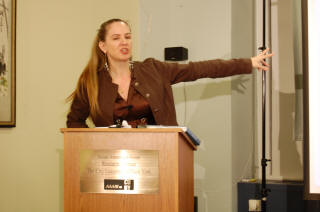
To investigate the interaction between speech recognition dictation technology and the use of language by non-native speakers of English, several language minority students from diverse ethnolinguistic backgrounds were asked to use speech recognition dictation software to orally compose a series of college level writing tasks. The interactions were videotaped and transcribed; the transcriptions include the participants’ verbal interactions, their non-verbal actions, and the actions of the computer.
The analysis of the transcripts draws on Halliday’s conceptual framework of register (field, tenor, and mode), emphasizing the relationship between the forms and the features of the context. Collectively, these three components serve to predict the register used with speech recognition dictation technology and to establish a general principle governing the ways in which the context of production was projected onto the text.

The findings indicate the manner in which the technology influenced the development of text and patterns of interaction. Many of the participants adopted a strategy of perfecting the composition as much as possible during the speech sessions. This strategy included making changes in the surface features of their talk in order to accommodate the software. Speech adjustments, associated with what I call “speech recognition talk,” included changes in lexical choice, utterance length, and pronunciation. In addition to these modifications in speech, many of the participants gained more control over oral phenomena that did not translate well into writing, such as filled pauses, false starts, meta-comments, and imprecise wording of oral punctuation commands. As part of the two-way interaction, the software improved in its recognition rate as these same participants updated their voice templates during the editing sessions.

The conclusions of this study offer a better understanding as to the influences of the situational features associated with speech recognition technology on spoken and written English. The recommendations include the expansion of possibilities associated with the transfer of modes offered by this technology, as well as insights into the advantages and constraints that the technology imposes on communication for language minority users.

